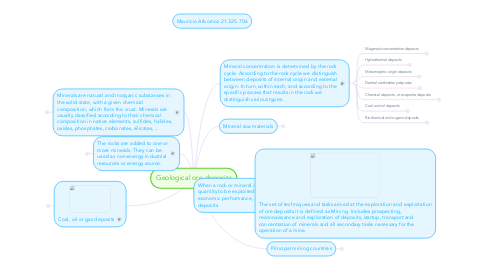Geological ore deposits
by Stephany Suarez

1. Minerals are natural and inorganic substances in the solid state, with a given chemical composition, which form the crust. Minerals are usually classified according to their chemical composition in native elements, sulfides, halides, oxides, phosphates, carbonates, silicates, ...
1.1. Pyrite (Sulfur and iron), Galena (Lead), Fluorite (Hydrofluoric acid).
2. The rocks are added to one or more minerals. They can be used as non-energy industrial resources or energy source.
2.1. Industrial rocks are those that are used directly or after simple preparation processes. Most rocks are destined for industrial construction: road paving, tiles, glass manufacture, manufacture of cement, bricks, ornamentation, and many others.
3. Coal, oil or gas deposits
3.1. They are types of sedimentary-organic deposits
3.2. Coal is formed by deposition and transformation of plant debris accumulated in flooded media (Wetlands and ponds)
3.3. Oil is formed from the remains of plankton that at death they sink to the bottom of marine basins.
3.4. The gas deposits usually appear associated with oil deposits.
4. Mauricio Albornoz 21.325.706
5. Mineral concentration is determined by the rock cycle. According to the rock cycle we distinguish between deposits of internal origin and external origin. In turn, within each, and according to the specific process that results in the rock we distinguish various types.
5.1. Magmatic concentration deposits
5.1.1. Originate from the magma or molten materials inside the earth
5.2. Hydrothermal deposits
5.2.1. Occur in the final stages of the process to precipitate magmatic substances in water or gas crystallize. Usually originate in fractured rocks or reefs.
5.3. Metamorphic origin deposits
5.3.1. Mineralogical and textural changes of rocks varying conditions of temperature and pressure.
5.4. Detrital sedimentary deposits
5.4.1. Materials carried by various external agents are deposited to lose strength
5.5. Chemical deposits, or evaporite deposits
5.5.1. Originate in marine or lacustrine basins, where the water evaporates and the elements carried in solution concentrated to saturate the water and precipitate at the bottom.
5.6. Coal and oil deposits
5.6.1. They are formed from organic remains covered by sediments. For a long time they have been subjected to anaerobic processes to result rich rocks in hydrocarbons.
5.7. Biochemical and organic deposits
5.7.1. These are produced by a large concentration or accumulation of organic remains (shells, carapaces, skeletons)
6. When a rock or mineral is in sufficient quantity to be exploited obtaining good economic performance, we talk about deposits.
7. Mineral raw materials
7.1. Fuels or energy: Includes fossil fuels (coal, oil, natural gas and hydrocarbons), and thorium and uranium minerals that are used as fuel for nuclear power reactors.
7.2. No metal or industrial: Includes rocks and minerals in the ore itself or a compound derived from it, has a utility or industrial application (aggregates, ornamental stones, abrasives, absorbents, lubricants, and many others).
7.3. Metal: Includes all the minerals from which metals are extracted.
8. The set of techniques and tasks aimed at the exploration and exploitation of ore deposits it is defined as Mining. Includes prospecting, reconnaissance and exploration of deposits, startup, transport and concentration of minerals and all secondary tasks necessary for the operation of a mine.
9. Principal mining countries
9.1. Investment in mining projects in Latin America is the largest in the world: Latin America 32%, Oceania 20%, Africa 16%, Asia 13%, North America 12% and Europe 7%. In turn, Chile, Brazil and Peru are the countries that invest more money in exploration and exploitation of mineral resources.
9.2. Bolivia is a mining country par excellence. This country explodes silver and tin, in addition to lead, zinc, antimony, cadmium and gold. Currently in Bolivia is in progress project involving the world's largest silver: The San Cristobal ore deposits.
9.3. Chile is considered a mining country in the world, as it is the largest producer of copper. It is a country mainly engaged in metal mining, such as gold, silver, iron and manganese. Among industrial minerals, the most important are the nitrates, borates, common salt and the lithium and potassium. There are also sources of clay, limestone, chalk, quartz, and others.
9.4. Brazil is a leading country in the production of minerals. Globally, Brazil is the largest producer of niobium, and second largest producer of iron. After China is the second largest producer of bauxite; the third largest producer of graphite, after China and India. Third largest manganese producer after South Africa and Australia. It also produces gold, copper, nickel, precious stones (topaz, aquamarine, emerald), phosphate, carbonate rocks cement, among others.
9.5. Mexico ranks second worldwide in the production of bismuth, third in silver production, fifth in the production of lead and sixth in the production of molybdenum and zinc. As for non-metalliferous reserves, is the third largest producer of celestite (strontium ore) and also has fluorite, barite, graphite, gypsum, phosphate and sulfur.
9.6. Mining in South Africa is the reason why the country is in the major world economies. South Africa is the largest producer of platinum in the world and one of the largest exporters of diamonds.
9.7. Africa has significant mining resources representing one third of world reserves. Africa attracts many investors.

